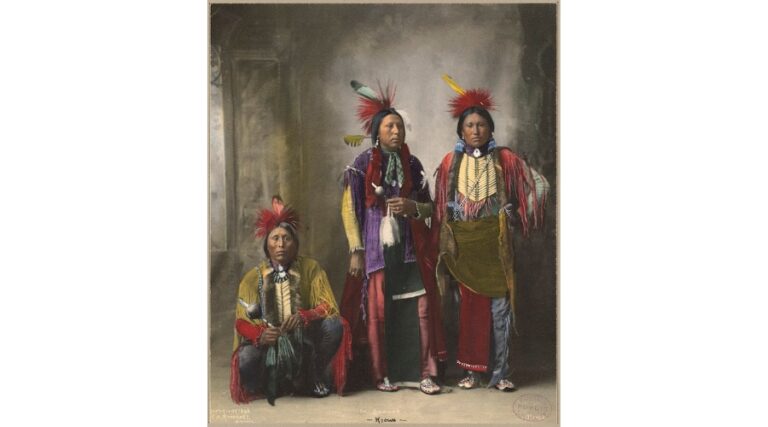The Kiowa tribe once roamed the wide-open plains of what is now the Texas Panhandle, leaving a legacy of courage, artistry, and adaptability. Known for their mastery of horseback warfare and rich oral traditions, the Kiowa played a major role in shaping the culture and history of the Southern Plains.
Origins and Southward Migration
The Kiowa people trace their origins to the northern Plains, near the headwaters of the Yellowstone and Missouri Rivers. Over time, they migrated south through the Black Hills region before moving onto the Southern Plains in search of better hunting grounds and horses.
Their movement brought them into contact with other tribes, including the Plains Apache, with whom they formed a long-standing alliance. By the 18th century, the Kiowa had established themselves across the Texas Panhandle and western Oklahoma, adapting perfectly to a nomadic, horse-centered life.
Life on the Southern Plains
The Kiowa thrived as nomadic buffalo hunters, following seasonal herds across the plains of Texas. They lived in tipis made from bison hides, which could be easily packed and transported as they moved from one camp to another.
Buffalo provided food, clothing, tools, and trade goods. Kiowa women were skilled in beadwork and hide painting, while men were expert horsemen and hunters. Horses became central to their identity, wealth, and warfare, symbolizing prestige within their society.
Social and Political Structure
Kiowa society was organized into bands, each led by respected chiefs who made decisions through consensus. Leadership was earned through bravery, wisdom, and generosity.
Among the most respected institutions was the Koitsenko, or “Ten Bravest” society—an elite group of warriors recognized for extraordinary courage. The Kiowa also maintained a network of age-graded warrior societies, which played vital roles in protecting their people and organizing communal hunts and ceremonies.
Beliefs, Arts, and Traditions

Spiritual life was deeply woven into Kiowa culture. The tribe held sacred ceremonies, including the Sun Dance, which reflected their connection to nature and the Creator. Though suppressed during the reservation era, it remains a symbol of Kiowa identity and resilience.
The Kiowa were also known for their ledger art, a storytelling tradition that recorded history through vivid drawings on animal hides or paper. Artists such as Silver Horn (Haungooah) became renowned for preserving battles, hunts, and ceremonies through these pictorial records. The tribe’s winter counts—yearly visual calendars—were another way they passed down collective memory through generations.
Alliances and Neighbors
One of the most significant alliances in Texas history was the Kiowa–Comanche–Apache confederation. This powerful union dominated the Southern Plains, including much of the Texas Panhandle and Red River country.
Together, they shared trade, defense, and cultural ties, resisting encroachment from other tribes and European powers. Their combined strength made them a formidable presence to both Spanish and later American forces.
Encounters with Spain, Mexico, and the United States
As European and later American expansion reached the Plains, the Kiowa engaged in both trade and conflict with newcomers. They traded horses, hides, and captives with merchants from New Mexico and Texas but also defended their homelands fiercely.
The Medicine Lodge Treaty of 1867 marked a turning point, as the Kiowa agreed to move onto a reservation in Indian Territory (present-day Oklahoma). Yet, disputes over violations of treaty terms soon led to renewed resistance and tragic consequences for their leaders.
Wars, Treaties, and Dispossession

Tensions escalated during the Red River War (1874–1875), when U.S. forces launched campaigns against Kiowa, Comanche, and other tribes resisting confinement. Battles at Adobe Walls and Palo Duro Canyon in the Texas Panhandle resulted in devastating losses for the Kiowa, as the U.S. Army destroyed their horses, food stores, and villages.
By 1875, the Kiowa were forced to relocate permanently to Fort Sill, Oklahoma, marking the end of their free-roaming life on the Texas plains.
From Reservation Era to Today
Despite hardship, the Kiowa people preserved their identity through language, art, and ceremony. Today, the Kiowa Tribe is headquartered in Carnegie, Oklahoma, where they continue cultural preservation efforts, language revitalization programs, and community gatherings.
Many Kiowa families maintain deep ancestral connections to Texas, and visitors can explore historic markers, museums, and sites throughout the Panhandle that highlight their legacy.
The Kiowa Legacy in Texas
The Kiowa left an enduring mark on Texas history through their alliances, artistry, and resilience. Their mastery of the horse and their vibrant storytelling traditions helped shape the cultural landscape of the Southern Plains.
From the rolling grasslands of the Panhandle to the archives of Texas museums, the spirit of the Kiowa continues to live on—reminding us of a proud people who once rode freely beneath the vast Texas sky.


